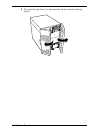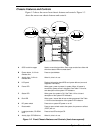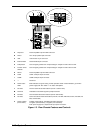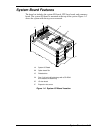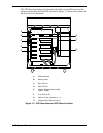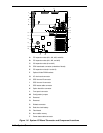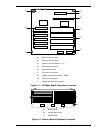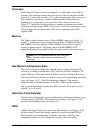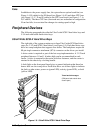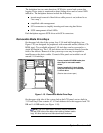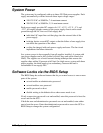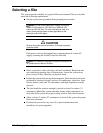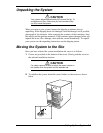
1-16 System Overview
Processor
Each Pentium II Xeon processor is packaged in a single edge contact (S.E.C.)
cartridge. The cartridge includes the processor core with an integrated 16 KB
primary (L1) cache; the secondary (L2) cache; a thermal plate; and a back cover.
The cartridge is secured by a retention module attached to the baseboard.
Depending on configuration, your system has one to four processors (see
Figure 1-7). Additional Pentium processors enhance performance and enable
symmetric multiprocessing (SMP). All processors access the same memory and
I/O space and tasks can run on either CPU if your operating system (OS)
supports SMP.
Memory
The Memory board contains sixteen 168-pin DIMM sockets (see Figure 1-8,
A and C). A minimum system configuration includes 128 MB (using four 32
MB DIMMs) of system memory. Sixteen DIMM sockets allow for system
memory expansion up to 4 GB (using sixteen 256 MB DIMMs). ECC
generation/checking is provided for detection and correction of memory errors.
Note:
Only use DIMMs approved for use in this server
system. Call your customer service representative for
information.
Bus Master I/O Expansion Slots
The server's expansion capabilities meet the needs of high performance I/O
servers by providing a combination of PCI local bus and ISA connectors. The
system I/O board offers nine dedicated PCI slots and two dedicated ISA slots.
The system I/O board contains two ISA bus master I/O (input/output) expansion
slots (see Figure 1-6, C). The ISA architecture supports 32-bit memory
addressing and 16-bit data transfers for the CPU, DMA, and bus masters.
The system I/O board also contains nine PCI bus master I/O expansion slots
(Figure 1-6, A, B, and E).
Real-Time Clock/Calendar
The real-time clock provides system clock/calendar information stored in a non-
volatile memory (NVRAM). The real-time clock battery (see Figure 1-6, Q)
provides power backup for the real-time clock.
BIOS
A BIOS and Setup Utility are located in the Flash memory (see Figure 1-6, R)
on the system I/O board and include support for system setup and PCI/ISA
Plug-and-Play auto-configuration. A number of security, reliability, and
management features are also incorporated to meet vital server needs.



